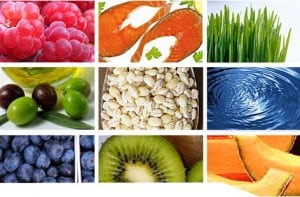General Description for a Low-Residue Diet
A low-residue diet consists of foods that are very low in dietary fiber. Foods that are omitted include those of moderate and of high fiber content as well as those foods that are believed to increase the fecal residue despite the low content of fiber. The calculated dietary fiber content of the low residue diet is less than 8 grams per day (or 3.5 per 1,000 Kcal).
Nutritional Inadequacy
The diet may be low in a number of nutrients. It is intended to be used for a short time period only. If the long-‐ term use of a low residue diet is indicated, supplementation with either a multivitamin, a monomeric of a polymeric formula, or parenteral nutrition should be considered.
Indications and Rationale
The diet may be used during acute exacerbations of inflammatory bowel disease (Crohn’s disease, ulcerative colitis) or of diverticulitis and in partial obstruction. It is also used pre- and postoperatively for intestinal surgery. It allows the bowel to rest by minimizing the fecal volume while still allowing the patient to consume food.
The term “residue” refers to unabsorbed dietary constituents, sloughed cells from the gastrointestinal tract, and intestinal bacteria. Some foods, such as milk and the connective tissue of meats, are low in dietary fiber, but may contribute to stool volume, particularly in individuals with altered gastrointestinal capabilities. The restriction of these so-called residue producing foods is based more on tradition and is not well documented in the literature.
Goals of Dietary Management
The goal of the low residue diet is to allow the bowel to rest by minimizing the fecal volume and to allow the patient to consume food. Nutrition therapy is directed towards establishing a tolerance to food. Therefore, the diet is intended to be used for a short time period only and as a transition from a liquid diet to foods more moderate in fiber content.
Group |
Amount |
Foods Recommended |
Foods to limit
|
| Milk and Milk Products | 2-4 Servings | Whole, 2%, 1%, buttermilk, milk drinks; yogurt without seeds and fruit skins, ice cream without nuts and seeds, pudding, cream soups, cheese | Cheeses with seeds or peppercorns |
| Beverages | Variable | Pop, tea, coffee, water, alcohol in moderation | None |
| Fruit | 2 Servings maximum | One citrus fruit daily; cooked or canned fruit without seeds, fruit juice; applesauce and banana | Dried fruit (raisins, dates, & figs); fruit with skin; prune products, all fruit peelings |
| Vegetables | 1-2 Servings maximum | One dark green or yellow vegetable daily, tender cooked carrots, string beans, asparagus, beets, spinach, squash, broccoli, cauliflower, tomato sauce without seeds, vegetable juice, small amounts of cooked onions | Raw vegetables, olives; cooked corn, peas, green beans, and mushrooms |
| Cereals | 1-2 Servings | Corn or rice based cereals, including Rice Krispies, Apple Jacks, Special K, Rice Chex, Corn Flakes, Frosted Flakes, cooked cereals including oatmeal and grits | Bran or wheat based cereals; cereals with nuts, seeds, coconut of dried fruits |
| Breads/Starches | 4 or more | Enriched white bread, including plain, bakery, sourdough, Italian, French, seedless rye, seedless hotdog and hamburger buns, pretzels, saltines, plain muffins, biscuits, pancakes, waffles, plain coffee cakes, and sweet rolls, graham crackers | Products with whole grain, bran and wheat germ, any with nuts, seeds or dried fruit |
| Potatoes and Substitutes | 1 or more servings | Potatoes without skin, white rice, pasta, macaroni, refined noodles, potato chips | Brown or wild rice, whole grain pasta; potatoes with skin |
| Meat and Meat Substitutes | 5 Ounces or more | Tender meat, fish or fowl (all without tough connective, tissue); eggs, smooth peanut butter, cottage chesses | Beans, meats and chesses with seeds, chunky peanut butter |
| Fats | Variable | Butter, margarine, cream, mayonnaise, salad dressing without seeds, cooking oil | Salad dressing with seeds, peppercorns |
| Desserts/Sweets | Variable | Ice cream, frozen yogurt, puddings, custard, gelatin, plain cakes, pies, and cookies, plain chocolate hard candy, jelly, honey, syrup | Desserts contained nuts, seeds, coconut of fruit skins |
| Miscellaneous | Gravy sauces, seasonings in moderation, herbs, yellow mustard, ketchup, salt, soy sauce |
Helpful Links
Mayo Clinic – Tips on Eating a Low Residue Diet
Medline- Low Residue Diet Tips


